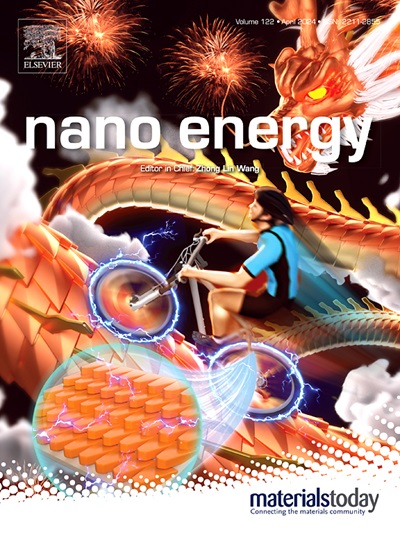Surface Electron-Rich State Induced Ti-O Terminal Activation on MXene Endow Ultra-High and Ultra-Stable Charge Storage
IF 16.8
1区 材料科学
Q1 CHEMISTRY, PHYSICAL
引用次数: 0
Abstract
Flexible supercapacitors have attracted significant attention recently because of the booming development of miniaturized, flexible portable energy storage devices. MXene is considered as a promising electrode material due to its superior conductivity and layered structure, however, the relatively low capacitance and unclear pseudocapacitive charge storage mechanisms have greatly limited their practical applications. Herein, a simple hydrothermal method has been employed to significantly improve the capacitance of Ti3C2Tx MXene via surface oxygen functional group activation and urea molecule intercalation. In-situ XRD and in-situ DRT, together with HRTEM, EELS, XPS, EPR and Raman studies, revealed the hydro-oxidized MXene were reduced by ammonia with incorporation of abundant oxygen vacancies, resulting in the activation of surface C-Ti-O functional groups. Furthermore, the urea intercalated MXene were accompanied by a reversible expansion and contraction of interlayer spacing during charging and discharging with more exploited pseudocapacitance, which did not exist in the pristine MXene. Therefore, the modified MXene exhibits more than 7-fold increase in specific capacitance compared to the pristine MXene, and also displays an exceptional rapid-charging capability with specific capacitance as high as 554 F g−1 at 30 A g-1. Besides, the modified MXene electrode shows around 92.8% capacitance retention over 50000 cycles. By using screen-printing technique, an all-solid-state flexible MXene//activated carbon asymmetric supercapacitor is fabricated and delivers an outstanding areal specific capacitance of 177 mF cm-2 and superior mechanical flexibility with 85% capacitance retention after 2000 cycle dynamic bending. This work brings new insight and expands the application potentials of MXene in the field of flexible energy storage devices.

MXene表面富电子态诱导的Ti-O末端活化可实现超高稳定电荷存储
近年来,由于小型化、柔性便携式储能装置的蓬勃发展,柔性超级电容器引起了人们的广泛关注。MXene由于其优异的电导率和层状结构被认为是一种很有前途的电极材料,但相对较低的电容和不明确的假电容电荷存储机制极大地限制了其实际应用。本文采用简单的水热方法,通过表面氧官能团活化和尿素分子插层,显著提高了Ti3C2Tx MXene的电容。原位XRD、原位DRT、HRTEM、EELS、XPS、EPR和Raman等研究表明,氨还原了氢氧化MXene,并引入了丰富的氧空位,导致表面C-Ti-O官能团活化。此外,尿素插层MXene在充放电过程中伴随着层间距的可逆膨胀和收缩,并且更多地利用了原始MXene中不存在的假电容。因此,与原始MXene相比,改进后的MXene的比电容增加了7倍以上,并且在30 A g-1下的比电容高达554 F g−1,具有出色的快速充电能力。此外,改性后的MXene电极在50000次循环中电容保持率约为92.8%。采用丝网印刷技术制备了全固态柔性MXene//活性炭不对称超级电容器,其面比电容为177 mF cm-2,在2000次循环动态弯曲后,其电容保持率为85%,具有优异的机械灵活性。这项工作带来了新的见解,拓展了MXene在柔性储能器件领域的应用潜力。
本文章由计算机程序翻译,如有差异,请以英文原文为准。
求助全文
约1分钟内获得全文
求助全文
来源期刊

Nano Energy
CHEMISTRY, PHYSICAL-NANOSCIENCE & NANOTECHNOLOGY
CiteScore
30.30
自引率
7.40%
发文量
1207
审稿时长
23 days
期刊介绍:
Nano Energy is a multidisciplinary, rapid-publication forum of original peer-reviewed contributions on the science and engineering of nanomaterials and nanodevices used in all forms of energy harvesting, conversion, storage, utilization and policy. Through its mixture of articles, reviews, communications, research news, and information on key developments, Nano Energy provides a comprehensive coverage of this exciting and dynamic field which joins nanoscience and nanotechnology with energy science. The journal is relevant to all those who are interested in nanomaterials solutions to the energy problem.
Nano Energy publishes original experimental and theoretical research on all aspects of energy-related research which utilizes nanomaterials and nanotechnology. Manuscripts of four types are considered: review articles which inform readers of the latest research and advances in energy science; rapid communications which feature exciting research breakthroughs in the field; full-length articles which report comprehensive research developments; and news and opinions which comment on topical issues or express views on the developments in related fields.
 求助内容:
求助内容: 应助结果提醒方式:
应助结果提醒方式:


